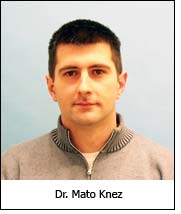Interviews
Metal-infiltrated spider silk to have increased toughness
25 Apr '09
5 min read

Dr. Mato Knez
In order to make it clear that the process involved here no longer involves a coating process as is the case in standard ALD, the researchers refer to the modified technique as
"Multiple Pulsed Vapour Phase Infiltration" or MPI. By doing this, they wish to avoid any possible confusion in the future. "Actually, it was rather difficult for us to make it clear to colleagues that we are infiltrating materials using a process that previously was only used for coating."
The researchers were able to detect under the transmission electron microscope that metal atoms from the vapour phase could also creep into the interior of the spider silk. For these tests, a scientist from the Martin Luther University Halle-Wittenberg cut 90-nanometer-thin slices of the spider silk. The microscopic images did not explain, however, why the metal atoms increase the strength of the protein fibres. "Up to now, we only have a few pointers about this," says Mato Knez: for example, from NMR measurements, which the researchers at the University of Halle made of spider silks infiltrated with aluminium.
"This would indicate that the aluminium is present in a compound other than a typical aluminium oxide," says Knez. And he has a good idea which compound it is: "We assume that the metal atoms bind the protein molecules to each other." Hydrogen atoms usually form bridges between the molecules which, however, break far more easily than the strong compounds made using metal atoms. Thus, it becomes plausible for metal-infiltrated spider silk to withstand more weight than the natural version.
The better ductility can also be explained in this way. A thread of spider silk can be extended in length because its protein fibres run together like tangled wool in areas referred to as amorphous. In other locations, they arrange themselves in an orderly line like a neat ball of wool. "In these crystalline areas, the hydrogen bridges are probably also replaced by metal ions," says Mato Knez. Consequently, their order dissolves, the amorphous areas increase and with them the ductility.
Despite its dramatically improved properties, metal-infiltrated spider silk is unlikely to be used to reinforce either fenders or aircraft wings in the future. "It would probably be more or less impossible to obtain large volumes of natural spider silk," says Knez. The insects are very difficult to keep and are not particularly productive when it comes to spinning their silk. Nonetheless, Knez is convinced of the practical use of this power thrust for materials: "We are pretty certain that we will also be able to improve the properties of synthetic materials that imitate natural ones using our process."
"Multiple Pulsed Vapour Phase Infiltration" or MPI. By doing this, they wish to avoid any possible confusion in the future. "Actually, it was rather difficult for us to make it clear to colleagues that we are infiltrating materials using a process that previously was only used for coating."
The researchers were able to detect under the transmission electron microscope that metal atoms from the vapour phase could also creep into the interior of the spider silk. For these tests, a scientist from the Martin Luther University Halle-Wittenberg cut 90-nanometer-thin slices of the spider silk. The microscopic images did not explain, however, why the metal atoms increase the strength of the protein fibres. "Up to now, we only have a few pointers about this," says Mato Knez: for example, from NMR measurements, which the researchers at the University of Halle made of spider silks infiltrated with aluminium.
"This would indicate that the aluminium is present in a compound other than a typical aluminium oxide," says Knez. And he has a good idea which compound it is: "We assume that the metal atoms bind the protein molecules to each other." Hydrogen atoms usually form bridges between the molecules which, however, break far more easily than the strong compounds made using metal atoms. Thus, it becomes plausible for metal-infiltrated spider silk to withstand more weight than the natural version.
The better ductility can also be explained in this way. A thread of spider silk can be extended in length because its protein fibres run together like tangled wool in areas referred to as amorphous. In other locations, they arrange themselves in an orderly line like a neat ball of wool. "In these crystalline areas, the hydrogen bridges are probably also replaced by metal ions," says Mato Knez. Consequently, their order dissolves, the amorphous areas increase and with them the ductility.
Despite its dramatically improved properties, metal-infiltrated spider silk is unlikely to be used to reinforce either fenders or aircraft wings in the future. "It would probably be more or less impossible to obtain large volumes of natural spider silk," says Knez. The insects are very difficult to keep and are not particularly productive when it comes to spinning their silk. Nonetheless, Knez is convinced of the practical use of this power thrust for materials: "We are pretty certain that we will also be able to improve the properties of synthetic materials that imitate natural ones using our process."
Max Planck Society
Popular News
Leave your Comments
Editor’s Pick
Andreas Rass
ZIMMER AUSTRIA | Digital Printing Systems
Salvatore Piccione
Label - Salvatore Piccione
































-Ltd..jpg?tr=w-120,h-60,c-at_max,cm-pad_resize,bg-ffffff)





.jpg?tr=w-120,h-60,c-at_max,cm-pad_resize,bg-ffffff)
.jpg?tr=w-120,h-60,c-at_max,cm-pad_resize,bg-ffffff)






